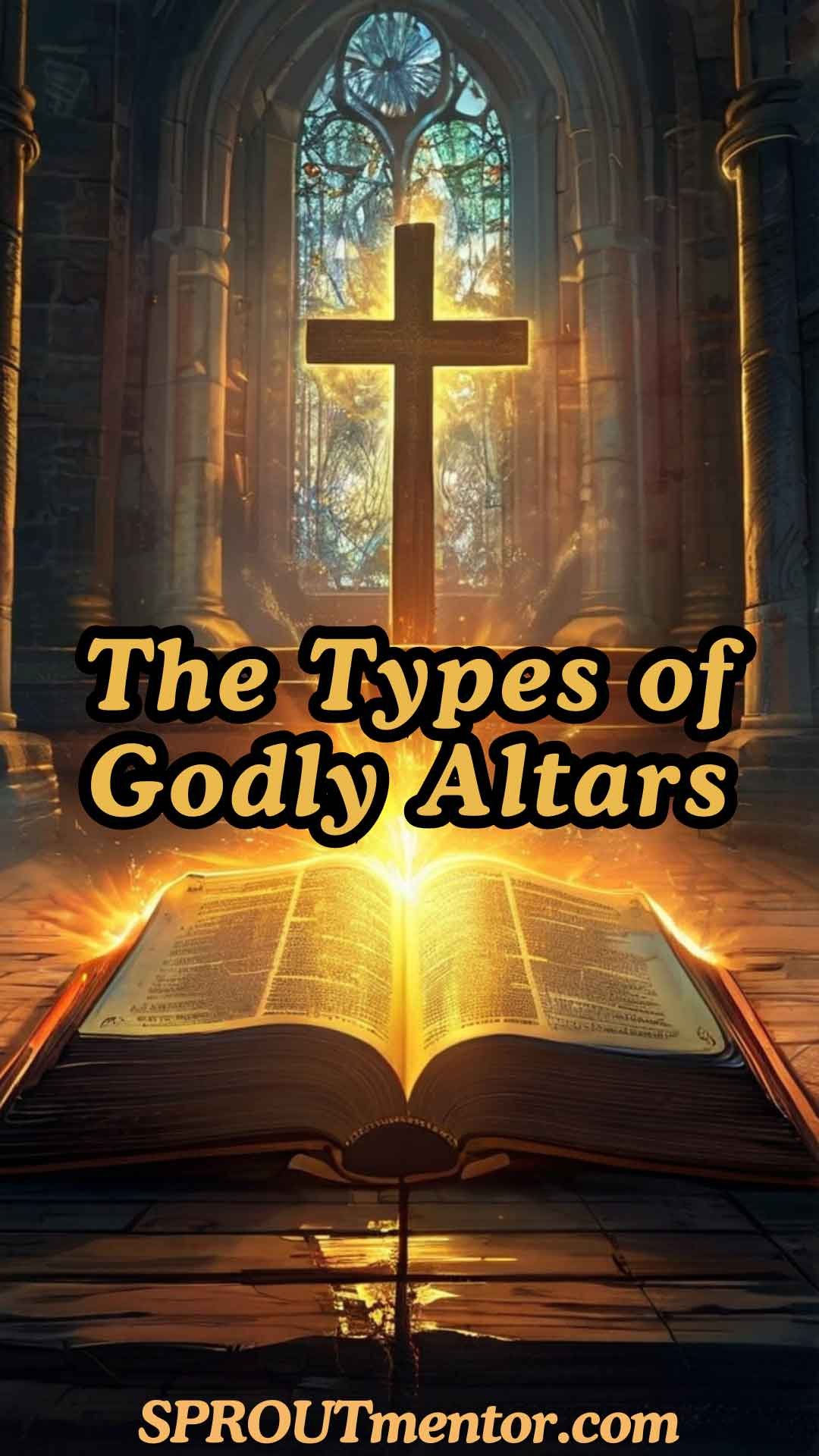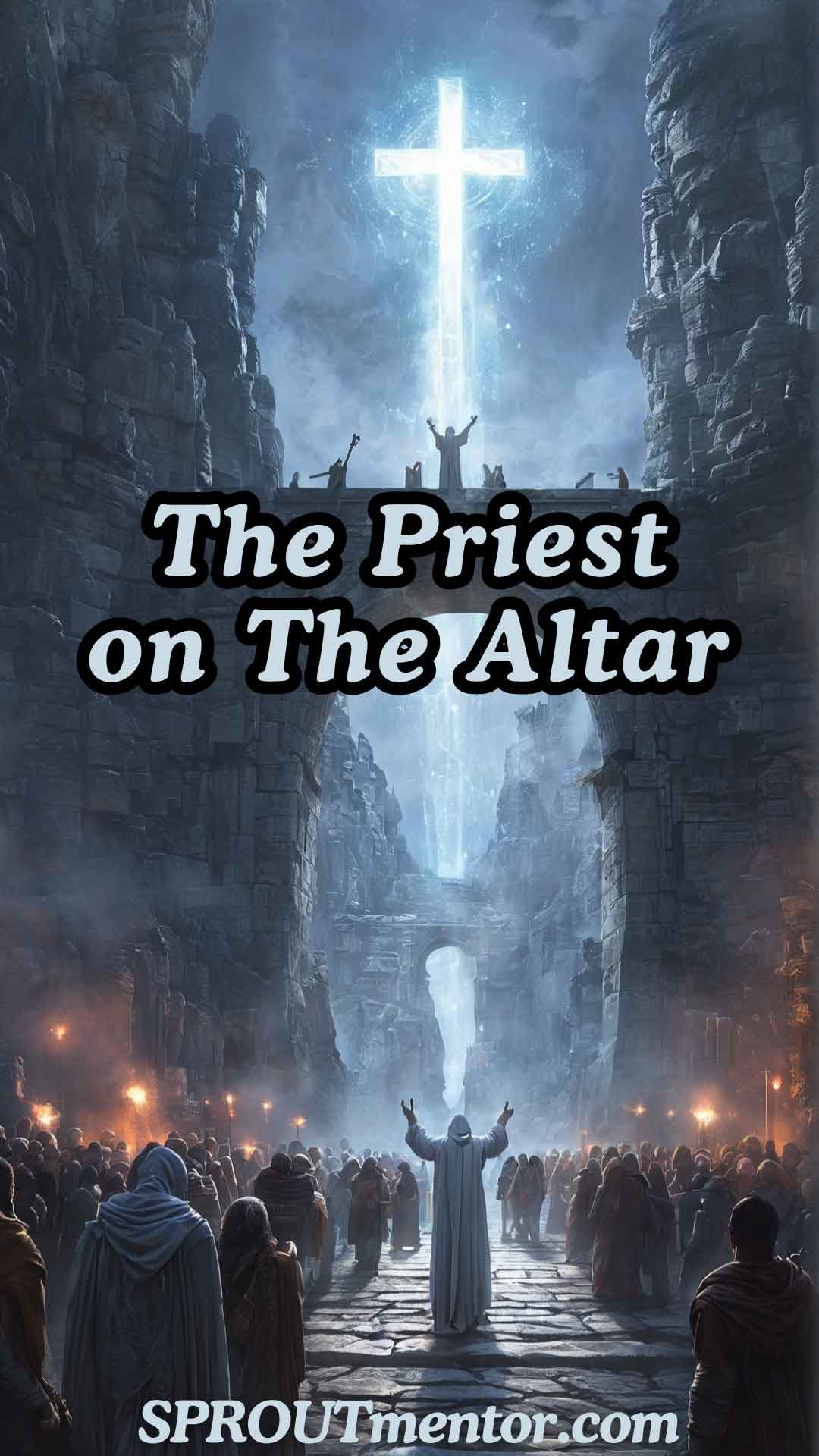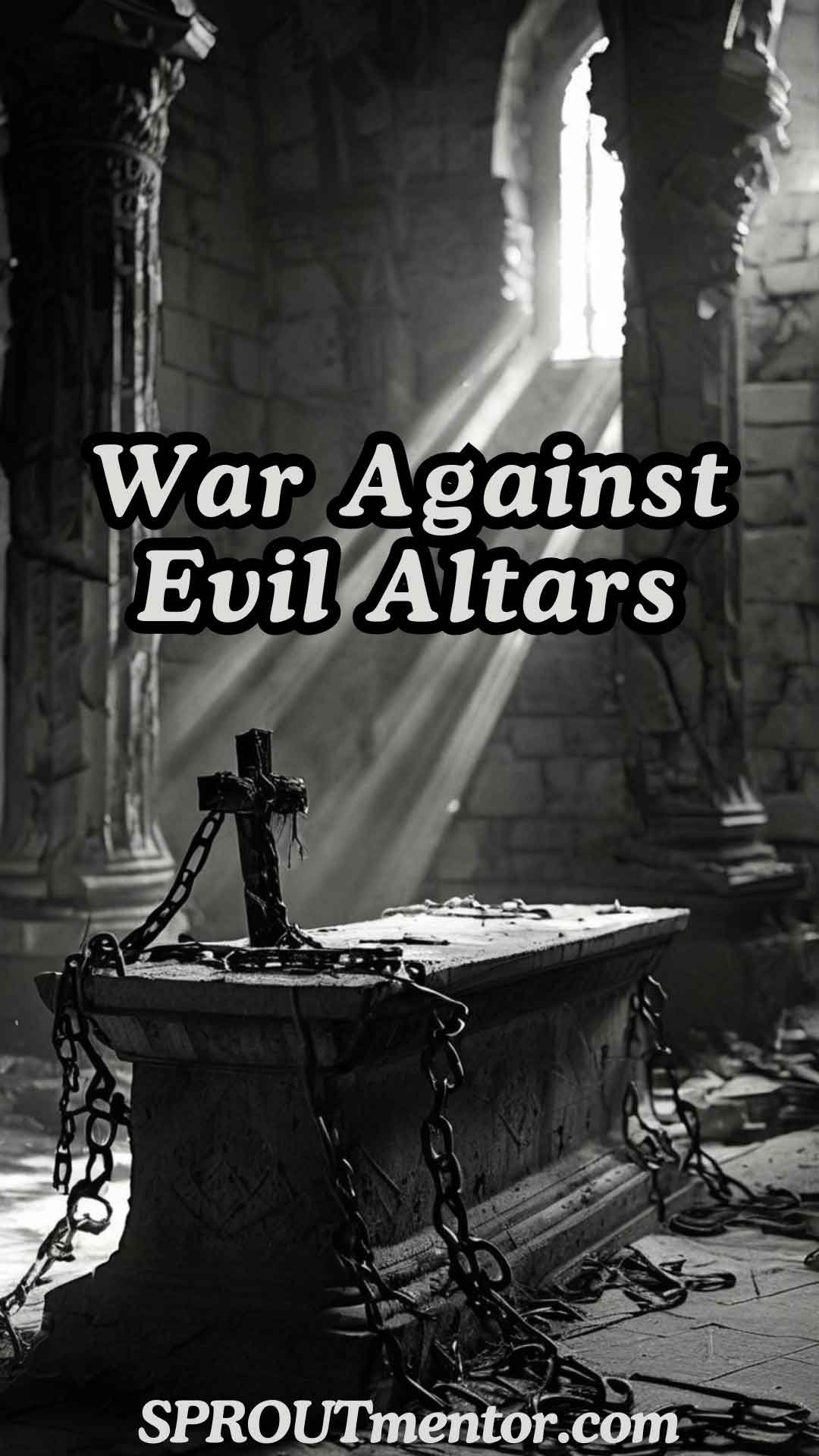The Types of Godly Altars

There are many types of altars.
These altars can be classified into four main dimensions of spiritual engagement—personal, familial, communal, and transitional altars.
#1 – PERSONAL ALTARS
These two foundational biblical figures—Abraham, the father of faith, and Jesus Christ, are the ultimate models of the kind of personal altars that God approves.
Altars by Abraham
The Altar of Consecration
Genesis 12:6-7 – “And Abram passed through the land unto the place of Sichem, unto the plain of Moreh. And the Canaanite was then in the land. And the Lord appeared unto Abram, and said, unto thy seed will I give this land: and there builded he an altar unto the Lord, who appeared unto him.”
- The first altar Abraham built was at Sichem (also called Shechem)
- This place, Sichem, means “shoulder,” symbolizing the idea of bearing burdens or transition.
- It was here that Abraham made his first public act of faith, transitioning from his idolatrous background to a new government—God’s rule.
- Before Abraham was called out of his family and native land [Genesis 12:1], he came from a society steeped in idolatry, worshiping celestial bodies like the moon.
- Abraham built this first altar as an act of consecration—he was formally disowning the gods of his past and declaring his allegiance to the God who had appeared to him.
- This altar signified Abraham’s willingness to abandon old ties and embrace the holiness of God.
- For modern believers, the Altar of Consecration represents the moment of signing off from the “government” of self, sin, and the world, and instead, committing to the Lordship of Jesus Christ.
- It’s akin to the vows made in marriage, where one disowns their former life and fully joins with their spouse.
- The key to living a life consecrated to God is separation from ungodly influences and making holiness your standard.
The Altar of Prayer
Genesis 12:8 – “And he removed from thence unto a mountain on the east of Bethel, and pitched his tent, having Bethel on the west, and Hai on the east: and there he builded an altar unto the Lord, and called upon the name of the Lord.”
- The second altar Abraham built was at Bethel, which means “House of God.”
- Here, Abraham “called on the name of the Lord”, signifying his initiation of a personal prayer life.
- Once you choose to step out of Satan’s control at the altar of consecration, he will launch all sorts of attacks to deter and discourage you.
- The altar of prayer serves as a reminder that after choosing to walk with God, one must build a prayer altar that serves as a protective shield.
- Abraham’s altar stood between Bethel to the west and Ai (meaning “ruin” or “heap of ruins”) to the east, symbolizing a choice between the presence of God and spiritual desolation.
- This implies that if Abraham strayed from the altar of prayer, he would find himself in spiritual and societal ruin.
- For example, in Genesis 12:10, when a famine struck, Abraham veered away from his prayer altar and “went down” to Egypt, a place of compromise.
- Fortunately, in Genesis 13:1-4, we are told that Abraham “went up” again, returning to the place of his prayer altar in Bethel.
- Moreover, the prayer altar will only yield lasting results for you and your descendants too.
- In Genesis 28:18, we see that the city’s name had changed from Bethel to Luz, meaning “perversity.”
- Despite this shift, Jacob, Abraham’s grandson, was still able to encounter God at the same location, which he described as the “house of God” and the “gate of heaven.”
- This is proof that the devil cannot destroy the power of holy altars.
- Righteous altars only lose their power when the person attending or serving the altar [the priest] falls out of alignment with the supervising spirit.
- The altar at Bethel continued to speak during Jacob’s time because Abraham had lived in alignment with the principles of submission and consecration, established at his first altar.
- In our lives, building an altar of prayer is crucial for sustaining spiritual fortitude.
- Just as Abraham had to return to Bethel after veering off to Egypt, we too need to return to our prayer altar whenever we fall into spiritual compromise.
- Problems will inevitably arise, but as long as we remain steadfast at the prayer altar, we will be shielded from their damaging effects.
- A consistent prayer life establishes spiritual covering and protection in the face of challenges.
The Altar of Intimacy
Genesis 13:18 – “Then Abram removed his tent, and came and dwelt in the plain of Mamre, which is in Hebron, and built there an altar unto the Lord.”
- The third altar was built in Hebron, which means “friendship” or “communion.”
- Due to his consistency in maintaining the altars of consecration and prayer, Abraham reached a level of deep intimacy with God, becoming known as a friend of God [James 2:23].
- For instance, Abraham was able to intercede for the salvation of Sodom and Gomorrah because of his intimate relationship with God [Genesis 18:23-33].
- Also, in Genesis 20:7, God referred to Abraham as His prophet, a title unknown to men but recognized by God Himself.
- This was evidence of the deep moments of intimacy Abraham shared with the Lord, to the point that God saw him as His prophet.
- The Altar of Intimacy calls us to cultivate a friendship with God that transcends mere obedience or duty.
- It’s at this altar that believers begin to understand God’s heart and participate in His plans for nations, families, and individuals.
- This type of altar requires constant communion with God, where prayer is not just petitioning but deep fellowship and worship.
- Anyone with an active altar of intimacy lives by these actions:
- Dwelling [Psalm 91:1]: They don’t just visit God’s house; they dwell in His presence.
- Continued steadfastly [Acts 2:42]: The apostles gave themselves continually to the marks of Apostolic culture, not just once but repeatedly.
- Exercise [1 Timothy 4:7]: To exercise means to follow a consistent pattern or regimen, doing something repeatedly until mastery is achieved.
- Tarry [Luke 24:49]: Waiting on God with expectation, not leaving until that expectation is met.
- Be with Him [Mark 3:14]: Jesus chose His disciples to be with Him first before sending them out. Those who are sent are chosen based on intimacy developed in their secret interactions with Him.
- All these actions, and many others, demonstrate that God draws near to us when we draw near to Him [James 4:8], for “deep calls unto deep” [Psalm 42:7].
The Sacrifice Altar
Genesis 22:13 – “And Abraham lifted up his eyes, and looked, and behold behind him a ram caught in a thicket by his horns: and Abraham went and took the ram, and offered him up for a burnt offering in the stead of his son.”
- The most famous altar Abraham built is at Moriah, where he offered his son Isaac as a sacrifice [Genesis 22].
- A sacrifice, by its very nature, is something that costs us dearly—something of great value that we give up in obedience to God.
- In 2 Samuel 24:24, David says, “I will not offer burnt offerings to the Lord my God that cost me nothing.”
- This principle emphasizes the importance of offering something of significance to God, recognizing that true sacrifice involves surrendering what is precious to us.
- The Sacrifice Altar Abraham built was where he was willing to offer his son, Isaac, demonstrating his complete trust and obedience to God’s command.
- Though God ultimately provided a ram in Isaac’s place, the act of faith still carried immense weight.
- It showed that Abraham was willing to give up his most cherished possession—his son—out of love and reverence for God.
- Whether it is time, resources, or personal ambitions, the altar of sacrifice represents a heart fully surrendered to God’s will, acknowledging that He is worthy of our most valuable offerings.
- The altar of sacrifice requires that we offer up not just material possessions but our very lives, dreams, and desires to God.
- Sacrifice is the hallmark of a covenanted life with God.
- Psalm 50:5 reinforces the idea that those who are in covenant with God have made sacrifices that cost them something significant.
- This altar seals covenants with God and has the power to bring generational blessings, as seen in how Abraham’s act covered not just himself but all humanity.
[B] Altars by Jesus
The Altar of Surrender
Luke 22:42 – “Not My will, but Yours be done”
- In the Garden of Gethsemane, Jesus demonstrated complete trust in the Father’s plan, even when it involved immense suffering.
- The altar of surrender requires total abandonment of self-reliance and a recognition that God’s ways are higher than our own.
- True surrender often involves relinquishing control over our future, trusting that God’s plans are always for our good [Jeremiah 29:11; Romans 8:28].
- At this altar, we learn the depth of faith it takes to walk in God’s will, even when it doesn’t align with our desires or understanding.
- Surrender is a daily act, where we continually choose God’s direction over our own, recognizing that His wisdom is far greater than ours [Proverbs 3:5-6].
The Altar of Obedience
Philippians 2:8 – “And being found in appearance as a man, He humbled Himself by becoming obedient to death—even death on a cross.”
- Obedience is not only about major sacrifices but also about daily choices to follow God’s Word, even in the small things.
- Just as Jesus was obedient unto death, the altar of obedience invites believers to follow God’s instructions, no matter how difficult or uncomfortable.
- Radical obedience often leads to unexpected blessings, as seen in Abraham’s willingness to sacrifice Isaac, which resulted in God providing a ram [Genesis 22:12-13].
- True obedience stems from love, not fear, as Jesus said, “If you love Me, keep My commandments” [John 14:15].
- Through obedience, we build a life that aligns with God’s will, positioning ourselves to be vessels for His purpose.
The Altar of Intimacy
Luke 5:16 – “And he withdrew himself into the wilderness, and prayed.”
- Throughout His ministry, Jesus frequently withdrew to solitary places to pray.
- These moments represent the altar of intimacy, where Jesus sought deep communion with the Father.
- Whether before choosing His disciples or after performing miracles, Jesus made intimacy with God a priority.
- In the midst of a busy world, the altar of intimacy calls us to carve out time for personal fellowship with God.
- This altar is where we learn to hear God’s voice, align our hearts with His, and be refreshed in His presence.
- Without this altar, our spiritual lives will run dry.
- The Altar of Intimacy is where our relationship with God deepens, moving beyond asking for things to experiencing His heart.
- In intimacy, we find rest, wisdom, and the ability to navigate life’s challenges, just as Jesus withdrew to pray before major decisions.
- This altar sustains our spiritual life, preventing burnout and keeping our focus on God amid life’s distractions.
- At the altar of intimacy, we also experience personal transformation, as time in God’s presence molds our character to reflect Christ.
- Without consistent intimacy, our spiritual power and discernment can diminish, weakening our ability to impact others.
The Altar of Compassion
Matthew 9:36 – “But when He saw the multitudes, He was moved with compassion on them, because they fainted, and were scattered abroad, as sheep having no shepherd.”
- Jesus’ heart broke for the lost, the sick, and the needy.
- The altar of compassion is demonstrated in how Jesus ministered to people—healing the sick, casting out demons, and feeding the hungry.
- Compassion moved Jesus to action, and the Altar of Compassion compels us to serve others out of love, not obligation.
- Jesus not only healed physical ailments but also addressed spiritual brokenness, showing that true compassion involves holistic care.
- Compassion also requires us to look beyond ourselves, stepping into the lives of others to bring God’s healing, comfort, and truth.
- Building this altar means allowing our hearts to break for what breaks God’s heart, aligning our mission with His to serve the least, the lost, and the lonely [Matthew 25:35-40].
- Compassionate living goes beyond random acts of kindness; it’s a lifestyle that reflects the unconditional love of Christ for everyone, regardless of their background or situation.
The Altar of Sacrifice
John 15:13 – “Greater love has no one than this: to lay down one’s life for one’s friends.”
- The Altar of Sacrifice calls us to offer ourselves as living sacrifices, holy and pleasing to God [Romans 12:1].
- True sacrifice is often costly, requiring us to give up something valuable for the sake of others or the Kingdom.
- The greatest expression of love is found in sacrifice, as seen in Christ’s willingness to die for our sins, even when we were undeserving.
- Sacrifice involves giving without expecting anything in return, mirroring Jesus’ selfless love for humanity.
- At this altar, we learn the joy of giving, as Jesus said, “It is more blessed to give than to receive” [Acts 20:35], finding fulfillment in living for others and advancing God’s purposes.

#2 – FAMILIAL ALTARS
A familial altar is a spiritual platform where the household gathers for worship, prayer, and sanctification.
It is led by the head of the family and serves as the spiritual covering for all members.
The family altar facilitates regular spiritual activities, ensuring that the household remains aligned with God’s will and protected from spiritual attacks.
Just as individuals are called to personal altars, families too are called to establish a space for collective spiritual engagement.
Below are five biblical examples of familial altars:
The Altar of Sanctification
Job 1:5 – “Job would send and consecrate them, rising early in the morning to offer burnt offerings according to the number of them all. For Job said, ‘It may be that my children have sinned and cursed God in their hearts.’ Thus, Job did continually.”
- Job continually sanctified his family, offering sacrifices on their behalf to cover potential sins.
- He interceded for his household, asking for God’s mercy and forgiveness for any sins that might disrupt the family’s spiritual atmosphere.
- Family members gather regularly at this altar to confess sins, seek forgiveness, and ensure their spiritual state remains pure before God.
The Altar of Blessing
Genesis 24:60 – “And they blessed Rebekah and said to her, ‘Our sister, may you become thousands of ten thousand, and may your offspring possess the gate of those who hate him!'”
- Before Rebekah left her family to marry Isaac, her relatives blessed her at a familial altar.
- This represents the altar of blessing, where family members are blessed before embarking on significant life transitions such as marriage or ministry.
- Familial altars are spaces for releasing prophetic words, prayers of blessing, and commissioning family members into new phases of their lives, under God’s guidance and favor.
The Altar of Consecration
Genesis 35:2-3 – “So Jacob said to his household and to all who were with him, ‘Put away the foreign gods that are among you and purify yourselves and change your garments.'”
- Jacob consecrated his family by instructing them to rid themselves of idols before building an altar to God at Bethel.
- The altar of consecration calls families to set themselves apart for God by removing anything that hinders their relationship with Him.
- At this familial altar, households dedicate themselves fully to God, purging distractions, idols, or anything that takes precedence over their worship of God.
The Altar of Covenant
Genesis 8:20-21 – “Then Noah built an altar to the Lord and took some of every clean animal and some of every clean bird and offered burnt offerings on the altar.”
- After the flood, Noah built an altar to God, marking a new covenant for his family and humanity.
- The altar of covenant is a place where families reaffirm their relationship with God, pledging to walk according to His commands and receive His promises.
- Families establish a covenantal relationship with God at this altar, committing to follow His will and trusting Him to bless future generations.
The Altar of Deliverance
Exodus 12:21-23 – “Then Moses called all the elders of Israel and said to them, ‘Go and select lambs for yourselves according to your clans, and kill the Passover lamb… And the Lord will pass over the door and will not allow the destroyer to enter your houses to strike you.'”
- During the Passover, each household in Israel built an altar by sacrificing a lamb and applying its blood on their doorposts for divine protection.
- This familial altar served as a place of deliverance, where God protected the Israelites from the death plague.
- The altar of deliverance is where families seek God’s intervention and protection during times of spiritual warfare, ensuring that no harm befalls the household.

#3 – COMMUNAL ALTARS
A communal altar, also known as a corporate altar, is a spiritual platform where a larger group such as a congregation, community, or nation gathers for unified worship, prayer, and sacrifice.
A communal altar enables individuals to access the corporate anointing, which is more potent than what can be achieved through individual or familial altars.
The power of a communal altar lies in unity—when a group aligns itself in purpose, seeking God with one heart and one mind, the result is divine intervention as supported by:
Psalms 133 – “Behold, how good and how pleasant it is for brethren to dwell together in unity …. for there the Lord commanded the blessing, even life for evermore.”
Matthew 18:19-20 – “Again I say unto you, that if two of you shall agree on earth as touching anything that they shall ask, it shall be done for them of my Father which is in heaven. For where two or three are gathered together in my name, there am I in the midst of them.”
Below are biblical examples of communal altars:
The Altar of National Deliverance
1 Kings 18:30-39 – “Then Elijah said to all the people, ‘Come near to me.’ And all the people came near to him. And he repaired the altar of the Lord that had been thrown down… And when all the people saw it, they fell on their faces and said, ‘The Lord, he is God; the Lord, he is God.'”
- Elijah called the nation of Israel to a communal altar on Mount Carmel to confront the prophets of Baal.
- This altar became a place of national repentance and deliverance.
- Through unified worship and Elijah’s sacrifice, God displayed His power by sending fire from heaven, leading the people to recognize and proclaim God’s sovereignty.
- This altar symbolizes how a corporate altar can bring about national deliverance, turning the hearts of an entire nation back to God.
The Altar of Corporate Repentance
Nehemiah 9:1-3 – “Now on the twenty-fourth day of this month, the people of Israel were assembled with fasting and in sackcloth, and with earth on their heads… And they stood up in their place and read from the Book of the Law of the Lord their God for a quarter of the day.”
- After the rebuilding of Jerusalem’s walls, the Israelites gathered at a communal altar to confess their sins and the sins of their ancestors, engaging in corporate repentance.
- This altar served as a platform for the entire nation to seek God’s forgiveness and recommit to following His laws.
- This example shows how a communal altar can foster collective repentance and realign a nation’s spiritual direction toward God.
The Altar of Corporate Blessing
Deuteronomy 33:5 – “And He was king in Jeshurun when the leaders of the people were gathered, all the tribes of Israel together.”
- Moses, as the spiritual and kingly leader of Israel, gathered the tribes at a communal altar where he blessed the entire nation.
- This altar demonstrates the power of corporate anointing as Moses released blessings that would shape the future and destiny of the Israelites.
- The communal altar provided an avenue for unified worship and blessing, creating a spiritual platform for divine favor and corporate anointing to flow.
The Altar of National Intercession
2 Chronicles 20:4-6 – “And Judah assembled to seek help from the Lord; from all the cities of Judah they came to seek the Lord… And Jehoshaphat stood in the assembly of Judah and Jerusalem, in the house of the Lord, before the new court.”
- Faced with an impending invasion, King Jehoshaphat called the people of Judah to a communal altar of prayer and fasting to seek divine intervention.
- This collective intercession led to God’s miraculous intervention, confusing their enemies and bringing deliverance without Judah needing to fight.
- This communal altar demonstrates the power of corporate intercession in invoking God’s protection and guidance in times of crisis.
The Altar of Corporate Worship
2 Chronicles 5:13-14 – “And it was the duty of the trumpeters and singers to make themselves heard in unison in praise and thanksgiving to the Lord… the glory of the Lord filled the house of God.”
- When Solomon completed the temple, the people gathered at a communal altar for worship and dedication. Their unified worship attracted the manifest presence of God, filling the temple with His glory.
- This altar of corporate worship released God’s tangible presence in such a way that the priests could not even stand to minister due to the overwhelming glory.
- This example highlights how communal worship at a corporate altar can invite God’s manifest presence in profound and transformative ways.
The Altar of National Covenant Renewal
Joshua 8:30-35 – “Then Joshua built an altar to the Lord, the God of Israel, on Mount Ebal… And there, in the presence of the people of Israel, he wrote on the stones a copy of the law of Moses.”
- After entering the Promised Land, Joshua led the entire nation of Israel to a communal altar where they renewed their covenant with God.
- This altar was a place of sacrifice, reading the law, and reaffirming the nation’s commitment to follow God’s commands.
- This communal altar represents a place of covenant renewal, where an entire nation recommits to walking in God’s ways and receiving His promises.
The Altar of Unified Prayer
Acts 2:1-4 – “When the day of Pentecost had fully come, they were all with one accord in one place… and they were all filled with the Holy Spirit and began to speak with other tongues, as the Spirit gave them utterance.”
- The upper room became a spiritual altar where 120 believers gathered, praying in unity, leading to the outpouring of the Holy Spirit.
- This altar demonstrates the collective power of corporate prayer and the role it plays in ushering in spiritual revival.
- The altar of Pentecost marked the birth of the Church and the release of supernatural empowerment for the believers to carry out their mission.
The Altar of Commissioning/Calling
Acts 13:2-3 – “While they were worshiping the Lord and fasting, the Holy Spirit said, ‘Set apart for me Barnabas and Saul for the work to which I have called them.’ Then, after fasting and praying, they laid their hands on them and sent them off.”
- In the church at Antioch, a communal altar was established through the practice of worship, fasting, and prayer.
- It was at this communal altar that the Holy Spirit commissioned Barnabas and Saul (Paul) for missionary work.
- This altar highlights how the collective prayers and fasting of the church can create an atmosphere where God’s guidance and direction are made clear.
- The altar of Antioch not only propelled the missionary movement of the early Church but also reinforced the significance of communal intercession for God’s will to unfold.

#4 – TRANSITIONAL ALTARS
Transition altars or altars of divine timing determine the flow of divine or demonic activities at critical times such as the start of a new day, year, or season.
Genesis 1:14 – “And God said, let there be lights in the firmament of the heaven to divide the day from the night; and let them be for signs, and for seasons, and for days, and years.”
The Day Altar
- Every new day represents a spiritual gateway.
- As things transition from the spiritual to the physical realm, they pass through what can be referred to as the “womb of a day.”
- In Esther 3:7, Haman used divination to find an auspicious day for his plan, illustrating the spiritual significance of controlling each day’s outcome.
- Similarly, we are encouraged to establish spiritual exercises that give us dominance over each day.
- For example, midnight prayers provide spiritual covering and ensure we control the spiritual outcome of the day.
The Year Altar
- The start of a year is a critical spiritual cycle.
- Many biblical figures marked the start of a year with significant spiritual acts, like sacrifices and vows.
- For example, Elkanah made an annual sacrifice and vow [1 Samuel 1:3].
- Also, most churches raise a corporate altar through the 40 days of prayer and fasting at the beginning of the year.
- Another example is where some people do charity work on their birthdays or fasting corresponding to the number of years they are turning.
The Seasons Altar
- Life stages (e.g., marriage, childbirth, ministry) are spiritual seasons that represent transition points in a person’s destiny.
- Each season can be marked and sanctified by appropriate sacrifices or spiritual exercises, such as fasting before marriage or ministry.
- These acts invite God’s presence and protection, ensuring that we fulfill His purposes during critical life transitions.
In conclusion …
There is a vast landscape of godly altars—from personal to communal, familial to transitional— sacred spaces.
But knowledge without action is like a flame without fuel.
It’s time to move from knowledge to action, from concept to consecration for you are the:
- Epistle the world is waiting to read [2 Corinthians 3:2]
- The son of God’s creation is eagerly waiting to deliver it from the bondage of corruption [Romans 8:19,21]
- Light of the world, called to shine before others [Matthew 5:14-16]
- Salt of the earth, preserving and flavoring society [Matthew 5:13]
- Ambassador for Christ, representing His kingdom [2 Corinthians 5:20]
- Living stone, being built into a spiritual house [1 Peter 2:5]
- Royal priesthood, declaring the praises of Him who called you [1 Peter 2:9]
In other words, your altar is not just about you—it’s a launching pad for revival, a beacon of hope in a darkened world, and a legacy that can impact generations to come.
So, how should you respond?
Here are a few starting points for your next steps:
- Preparation: This is lesson 11 in this science of altars teaching series. If you have not gone through the other lessons, make sure you do so first because priesthood is not for the ignorant [Hosea 4:6]
- Identification: What area of your life is crying out for divine intervention? Is it your walk with God, your family’s spiritual health, or perhaps a burning desire to see change in your community? Start by recognizing where you need to build or rebuild an altar.
- Action: Now read this blog post on How to Raise a Godly Altar to get a step-by-step guide on how to build these altars in your heart.
Are you feeling stuck in your Christian walk?
We offer a powerful collection of Christian ebooks designed to equip you for growth and empower you to live a life guided by your faith.
Share This Blog Post On:
Are you looking for a deeper understanding of your faith? I’m excited to let you know that I have written books that delve into scripture and offer insights to help you grow in your Christian walk. Learn more about my books by visiting this link.







